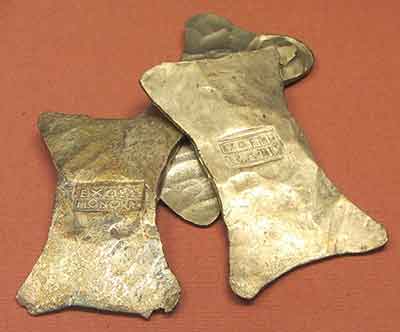Metal Crafts in Ancient Rome
Mining was a hazardous job done mostly by slaves or criminals. The conditions in the mines were very hazardous and unpleasant. Miners were lowered with a rope into a deep shaft. The mining tunnels themselves were only tall enough to crawl into. Flooding was also a problem in the mines. The Romans invented a water wheel system that was able to take the water out of the mines. (Snedden 1998) Stone or metal picks and shovels were used to dig out the minerals. The materials were taken back to the surface in grass-woven baskets. The miners would split rocks by heating them with a fire and the dousing the rock with vinegar. The sudden change in temperature would split the rocks.
Rome imported much of their ores from other areas. Gold and silver came from Spain and Greece, tin from Britain, copper from Italy, Spain and Cyprus. (Rees 1999).
Processing
|
|
After the ore was mined, it would be processed by smiths. The Romans learned that reheating iron between carbon would make a stronger metal steel. Iron was also used to make rings. Bronze was used frequently for everyday objects. Romans were able to use clay molds in which they poured the bronze to make a large variety of small items. Larger items would be cast to be hollow or have clay insides to limit the amount of the bronze material in the piece. A mixture of copper and zinc were used as a substitute for real gold. Gold would be worked into rings, earrings and chains for the wealthier Romans.
 The Romans mined for metals in every part of their empire. They sought both utilitarian metals such as iron, copper, tin, and lead, and the precious metals gold and silver. The desire for mineral resources may even have affected foreign policy. Before he invaded, Caesar knew of the rich tin deposits in Britain, a metal used in the production of bronze and in limited supply elsewhere in the empire [Caesar, 5.12].
The Romans mined for metals in every part of their empire. They sought both utilitarian metals such as iron, copper, tin, and lead, and the precious metals gold and silver. The desire for mineral resources may even have affected foreign policy. Before he invaded, Caesar knew of the rich tin deposits in Britain, a metal used in the production of bronze and in limited supply elsewhere in the empire [Caesar, 5.12].
Our knowledge of Roman mining comes from modern excavation reports of the mines and from literary sources, such as Diodorus of Sicily and Pliny. The written evidence does not discuss all aspects of mining, leaving out information such as how veins were located, what tools were used, or how drainage wheels were used to control water. When an author mentions a mine, it is rarely with enough information to identify an exact location. The mines themselves contain evidence for various processes, but we must interpret the remains. A number of Roman mines have been excavated and documented. Examples include the gold mine at Dolaucothi in Wales, and the extensive silver workings at Rio Tinto, Spain. Mining is a destructive process, so much evidence has been erased by Roman and later working. It is particularly difficult to date features such as shafts and tools. Some earlier mines, such as the Greek silver mine of Laurion, had a Roman period that may have had minimal effect on the mine features. The poor preservation of organic remains also limits the information. In Dolaucothi, for example, the investigators believe that only one board of a wooden drainage wheel survives in the mine because the other parts were burned in a fire set to loosen rock [Boon, p. 123].
Types of Roman mining
Despite these limitations, it is possible to develop a picture of Roman mining. The Romans employed three techniques to recover the metals. Pliny describes them
"Gold in our part of the world ... is found in three ways: first, in river deposits. ... No gold is more refined, for it is thoroughly polished by the very flow of the stream and by wear. The other methods are to mine it in excavated shafts or to look for it in the debris of undermined mountains." [XXXIII 66; Humphrey, et al., hereafter SB, p. 187]
The least difficult was surface mining, where the ore was available at the surface either in streambeds or exposed on the ground. The erosive power of streams broke up the ore and the heavier metals settled to the bottom in areas of slower flow. These are called placer deposits. Where the Romans recognized metal ores on the surface, they could follow them into the ground by strip-mining the surface ("the debris of undermined mountains"), or digging short tunnels. This technique, called opencast, was used for many metals.
The third technique, deep-vein mining, was the most difficult and dangerous. Only gold and silver were valuable enough to justify digging underground. After a suitable site was found, tunnels were excavated in the rock to remove the ore. Narrow vertical shafts were driven through the rock, widening out to horizontal galleries where the ore was found. Sometimes horizontal adits from a hillside were driven as well. Working below ground, the miners had to deal with the need for lighting, the dangers of poor ventilation, and the presence of water in the tunnels.




















